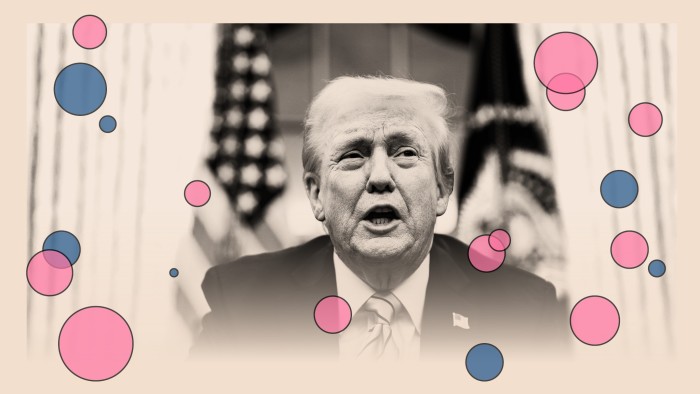Donald Trump has unveiled an overhaul of the US’s trading relationship with many of its partners and allies, launching what he dubs a “fair and reciprocal plan” for trade.
The president on Thursday signed a memo ordering his top advisers to come up with a “comprehensive” approach to tackle the US trade deficit, chiefly by raising tariffs to retaliate against taxes, levies, regulations and subsidies that Washington considers unfair.
The move is the latest trade salvo by Trump in his first month in office, and follows threats to unleash tariffs on the US’s North American trading partners, as well as new levies on metals imports.
What are ‘reciprocal’ tariffs?
In June 2023, Trump pledged that if he won the election he would pass a law through Congress allowing him to match US import tariffs to those imposed on US goods by other countries. His campaign billed it as “an eye for an eye, a tariff for a tariff, same exact amount”.
The approach taken has been broader. Officials said they would impose the levies on a “country by country” basis, retaliating against non-tariff barriers, too. They singled out the EU’s value added tax as an example of an unfair trade practice, along with the digital services taxes that have been explored or implemented by many European countries.
Everett Eissenstat, a former Trump trade official now at Squire Patton Boggs, said regulations ranging from agricultural standards to weight restrictions on cars could be in the crosshairs.
A White House fact sheet outlining the plan said the US was “one of the most open economies in the world” but argued that its trading partners “keep their markets closed to our exports”.
The US plan would break World Trade Organization rules, since members must offer the same rates to each other unless they conclude a bilateral or regional trade deal — the so-called most favoured nation principle.
While the US has long since stopped playing within WTO rules, moving to a system of reciprocity would mark a sharp departure for Washington’s trade policy.
It would also be different from the approach that Trump has adopted for trade in metals, in which the US has imposed a blanket 25 per cent tariff.
Which countries and products would be most affected?
A senior official on Thursday said Japan, India and the EU were the biggest targets of the new measures, while the White House fact sheet added Brazil to the list.
“Japan has relatively low tariffs but high structural barriers,” the official said. “Whereas India . . . has some of the highest tariffs in the world.”
Peter Navarro, Trump’s senior counsellor for manufacturing and trade, called the EU’s VAT “a poster child” for the measure that would be tackled by the US tariffs, arguing the EU offered unfair rebates to its own exporters. EU countries charge VAT only on products sold in the bloc, regardless of origin. The US has no VAT, just state sales taxes.
“[It] almost triples the EU’s tariff rate on American exports, even as it heavily subsidises the EU’s exports,” said Navarro.
Trump has previously complained about China, the EU and India, citing analysis from the Coalition for a Prosperous America, a pro-tariff think-tank. The White House on Thursday said India applied a 100 per cent tariff on US motorcycles, while the US charged only 2.4 per cent. It also said the EU blocked imports of shellfish from 48 states.
On the basis of tariffs, analysts at Morgan Stanley found India, Thailand and South Korea would be most exposed to retaliation, calculating they would be at risk of an increase of four to six percentage points in weighted average tariffs.
Morgan Stanley also found that Japan, Malaysia and the Philippines could be targeted, based on their higher average tariffs. Analysts at Barclays added Indonesia and Vietnam to that list.
The EU could also suffer. It levies 10 per cent on car imports, while the US only charges 2.5 per cent. Cars account for 8 per cent of EU exports to the US.
The US trade-weighted average tariff is 2.2 per cent, according to the WTO. By contrast, India’s average rate is 12 per cent and reaches 177 per cent for oilseeds, fats and oils.
Could US tariffs go down as well as up?
A White House official said on Thursday that the US was hoping to have a “discussion with the nations of the world about how imbalanced the trade environment is because of the existing structures”.
“The president is more than happy to lower tariffs if countries want to lower tariffs,” the official added, but argued that high tariffs were often less of a trade barrier than policies such as taxes.
Scott Lincicome, vice-president of the free-market Cato Institute think-tank, said a genuinely reciprocal system would bring down US tariffs on manufactured goods from Europe, Mexico, Canada, or the UK, where tariffs were sometimes lower.
“I am sceptical that our tariffs — for example the 25 per cent tariff on light trucks or ones on clothing and footwear — will go down,” he said.
The US is also a prolific user of trade defence instruments, emergency measures that deploy tariffs in specific cases, such as during import surges. Washington also ensures some subsidies are only available to domestic companies and uses regulatory standards to keep out foreign products.
“Many foreign nations do have protectionist barriers against American goods, services and investment, but the US is no saint,” said Lincicombe.
What has Trump done so far?
Trump has used the tariffs as a negotiating tool and a way to protect US industry, and has repeatedly railed against the country’s trade deficit. The order to draw up a reciprocal tariff plan comes alongside other measures, which often do not take a reciprocal approach.
The president’s threats to impose tariffs on Canada and Mexico forced both countries to hurry to show Washington they were making meaningful efforts to secure their borders and stymie fentanyl trafficking, in line with Trump’s demands.
Trump has also shown he is willing to apply steep tariffs to protect specific US industries, approving a blanket 25 per cent tariff on all imports of steel and aluminium beginning in March. Trump officials said there would be no exclusions for any companies or products.
He has also carried out his threat to impose 10 per cent tariffs on all imports from China, a move that hits everyday consumer goods.
Alongside these early actions, Trump has ordered his officials to conduct investigations into whether foreign countries are unfairly taxing US companies, the reasons for the US’s persistent trade deficit and whether countries are manipulating their currencies.
How will other countries respond?
Some countries are already acting. India this month slashed duties covering certain US imports including Harley-Davidson motorcycles, a longtime Trump complaint, which he has called “unacceptable”.
Although India is one of the world’s top buyers of Russian oil, Trump announced that the US would “be a leading supplier of oil and gas to India” during a press conference with Prime Minister Narendra Modi on Thursday.
He added that he and Modi would negotiate “long-running disparities” on trade.
The Financial Times has reported that EU officials would be willing to drop car tariffs to US levels if it avoided punitive action against its own exports. Brussels has openly said it would like to buy more US liquefied natural gas.
It is unclear how the EU and UK would respond to significant retaliation against their VAT regimes, which they see as neutral on trade and a core part of their tax systems. No other trading partner has raised such a threat.
EU officials told the FT they did not believe the bloc would change its regime under US pressure. It successfully defended the system against US measures at the WTO in the 1990s.
The EU has so far promised “firm and proportionate” retaliation to steel and aluminium tariffs, while the UK has said it is unlikely to respond, not wishing to fuel inflation.
China on Monday responded to US tariff increases with limited countermeasures affecting about $14bn of US imports. But its rhetoric has also been relatively restrained compared with the first round of the Trump trade war.
“There are no winners in a trade war or tariff war,” said China’s foreign ministry. “We urge the US side to stop politicising and weaponising economic and trade issues.”
Read the full article here




